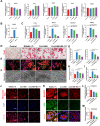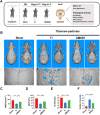CB2 regulates oxidative stress and osteoclastogenesis through NOX1-dependent signaling pathway in titanium particle-induced osteolysis
- PMID: 38104087
- PMCID: PMC10725463
- DOI: 10.1038/s41420-023-01761-y
CB2 regulates oxidative stress and osteoclastogenesis through NOX1-dependent signaling pathway in titanium particle-induced osteolysis
Abstract
Periprosthetic osteolysis (PPO) induced by wear particles at the interface between the prosthesis and bone is a crucial issue of periprosthetic bone loss and implant failure. After wear and tear, granular material accumulates around the joint prosthesis, causing a chronic inflammatory response, progressive osteoclast activation and eventual loosening of the prosthesis. Although many studies have been conducted to address bone loss after joint replacement surgeries, they have not fully addressed these issues. Focusing on osteoclast activation induced by particles has important theoretical implications. Cannabinoid type II receptor (CB2) is a seven-transmembrane receptor that is predominantly distributed in the human immune system and has been revealed to be highly expressed in bone-associated cells. Previous studies have shown that modulation of CB2 has a positive effect on bone metabolism. However, the exact mechanism has not yet been elucidated. In our experiments, we found that NOX1-mediated ROS accumulation was involved in titanium particle-stimulated osteoclast differentiation. Furthermore, we confirmed that CB2 blockade alleviated titanium particle-stimulated osteoclast activation by inhibiting the NOX1-mediated oxidative stress pathway. In animal experiments, downregulation of CB2 alleviated the occurrence of titanium particle-induced cranial osteolysis by inhibiting osteoclasts and scavenging intracellular ROS. Collectively, our results suggest that CB2 blockade may be an attractive and promising therapeutic scheme for particle-stimulated osteoclast differentiation and preventing PPO.
© 2023. The Author(s).
Conflict of interest statement
The authors declare no competing interests.
Figures






Similar articles
-
Genetic and pharmacological activation of Hedgehog signaling inhibits osteoclastogenesis and attenuates titanium particle-induced osteolysis partly through suppressing the JNK/c-Fos-NFATc1 cascade.Theranostics. 2020 May 17;10(15):6638-6660. doi: 10.7150/thno.44793. eCollection 2020. Theranostics. 2020. PMID: 32550895 Free PMC article.
-
Protein phosphatase 2A as a new target for downregulating osteoclastogenesis and alleviating titanium particle-induced bone resorption.Acta Biomater. 2018 Jun;73:488-499. doi: 10.1016/j.actbio.2018.04.013. Epub 2018 Apr 12. Acta Biomater. 2018. PMID: 29656074
-
NOX4 blockade suppresses titanium nanoparticle-induced bone destruction via activation of the Nrf2 signaling pathway.J Nanobiotechnology. 2022 May 23;20(1):241. doi: 10.1186/s12951-022-01413-w. J Nanobiotechnology. 2022. PMID: 35606794 Free PMC article.
-
Mechanism of regulating macrophages/osteoclasts in attenuating wear particle-induced aseptic osteolysis.Front Immunol. 2023 Oct 4;14:1274679. doi: 10.3389/fimmu.2023.1274679. eCollection 2023. Front Immunol. 2023. PMID: 37860014 Free PMC article. Review.
-
Wear and osteolysis in total joint replacements.Acta Orthop Scand Suppl. 1998 Feb;278:1-16. Acta Orthop Scand Suppl. 1998. PMID: 9524528 Review.
Cited by
-
TRPA1 aggravates osteoclastogenesis and osteoporosis through activating endoplasmic reticulum stress mediated by SRXN1.Cell Death Dis. 2024 Aug 27;15(8):624. doi: 10.1038/s41419-024-07018-5. Cell Death Dis. 2024. PMID: 39191723 Free PMC article.
-
The dual role of titanium particles in osteolysis: implications for gene therapy in prosthesis loosening.Eur J Med Res. 2025 Mar 29;30(1):216. doi: 10.1186/s40001-025-02452-3. Eur J Med Res. 2025. PMID: 40156068 Free PMC article.
-
Therapeutic Potential of Targeting Ferroptosis in Periprosthetic Osteolysis Induced by Ultra-High-Molecular-Weight Polyethylene Wear Debris.Biomedicines. 2025 Jan 13;13(1):170. doi: 10.3390/biomedicines13010170. Biomedicines. 2025. PMID: 39857757 Free PMC article.
References
LinkOut - more resources
Full Text Sources

